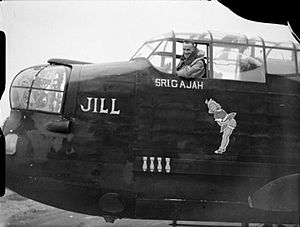No. 97 Squadron RAF facts for kids
Quick facts for kids No. 97 (Straits Settlements) Squadron RAF |
|
|---|---|
| Active | 1 December 1917 to 1 April 1920 September 1935 to 20 May 1940 25 February 1941 1 January 1956 1 December 1959 to 2 January 1967 |
| Country | |
| Branch | |
| Nickname(s) | Straits Settlements |
| Motto(s) | "Achieve your aim" |
| Insignia | |
| Squadron Badge heraldry | An ogress pierced by an arrow, point downwards. The badge is indicative of accurate aim. |
No. 97 (Straits Settlements) Squadron was a special unit of the Royal Air Force, also known as the RAF. It was first formed on 1 December 1917 in Waddington, England. This squadron played many important roles throughout its history, from bombing missions to carrying out secret operations.
Flying in World War I
The squadron began on 1 December 1917 at RAF Waddington. At first, it was a training unit, helping pilots learn to fly. Later, it received large Handley Page O/400 bomber planes.
In August 1917, the squadron moved to France. They flew 91 bombing missions during World War I. They dropped a total of 64 tons of bombs before the war ended.
Between the Big Wars
After World War I, from November 1918, 97 Squadron was based at RAF Saint Inglevert. They left there in March 1919. The squadron then got new planes called the Airco DH.10 Amiens.
Later, the squadron moved to India. It stayed there until it was officially closed down on 1 April 1920. At that time, it was renamed No. 60 Squadron. The squadron was started again on 16 September 1935 at RAF Catfoss. This time, they flew Handley Page Heyford planes.
World War II Missions
The squadron was closed down again in April 1940. But it reformed quickly on 25 February 1941 at Waddington. They started flying the Avro Manchester bomber.
Later, the squadron received the powerful Avro Lancaster bomber. In April 1943, they became a Pathfinder squadron. Pathfinders were special planes that flew ahead of the main bomber force. Their job was to mark targets with flares so other bombers could see where to drop their bombs.
The squadron also trained several pilots for a very important mission. These pilots later joined 617 Squadron. They took part in Operation Chastise, which was a famous bombing raid.
After the War
In July 1946, the squadron got new planes called the Avro Lincoln. They continued to fly missions until they were closed down at RAF Hemswell on 1 January 1956.
The squadron was started again on 1 December 1959. This time, it was called 97(SM) Sqn. The "SM" stood for Strategic Missile. This squadron was part of a project called Project Emily. They were equipped with three Thor missiles. These were large rockets that could travel long distances. The squadron was based at RAF Hemswell.
In October 1962, the world faced the Cuban Missile Crisis. During this time, the squadron was kept ready for action. Their missiles were aimed at important targets. This was a very tense period, but the crisis ended peacefully.
The squadron was closed down on 24 May 1963. This happened when the Thor missile program in Britain ended.
The squadron was then reformed one more time. This happened by renaming No. 151 Squadron. The change took place at RAF Watton on 25 May 1963. The squadron flew different planes, including the Vickers Varsity T.1, Canberra Mk B.2, and the Hastings C.2. On 2 January 1967, the squadron was closed down for the final time at Watton.
See also


